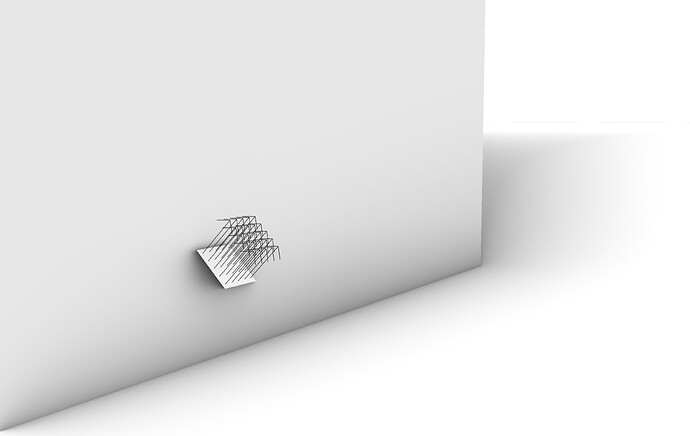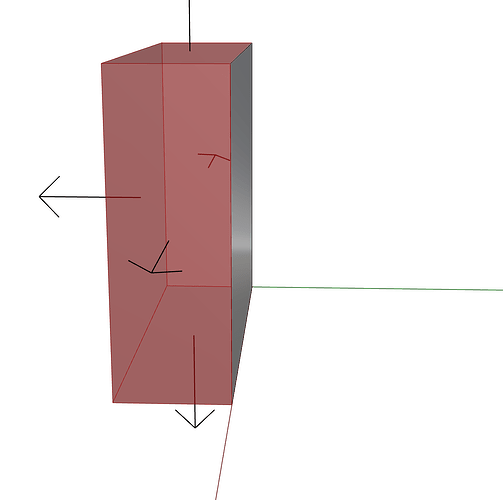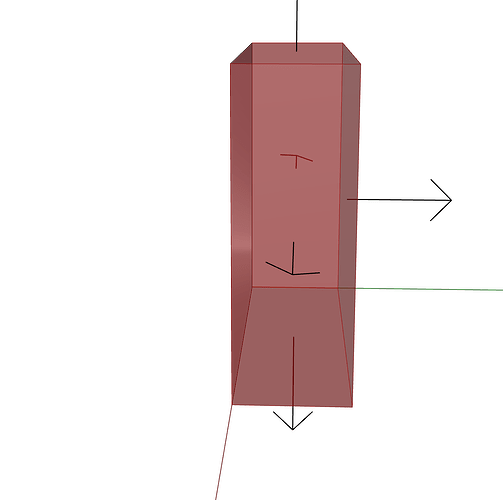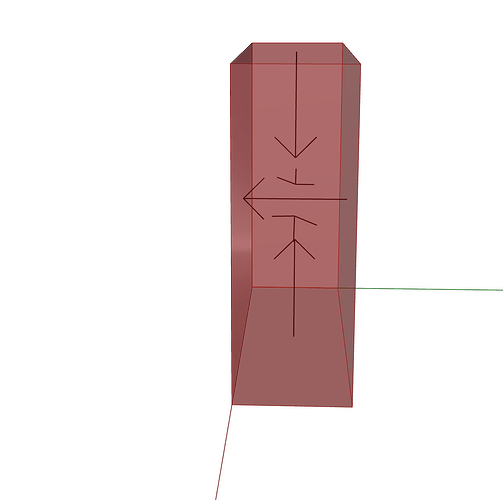When I look at the result totFin.txt:
##############
#?RADIANCE
rmtxop -faa -c 0.333333333 0.333333333 0.333333334 -t tot.mtx
oconv -f -i scene.oct receivers96.rad
rcontrib -fo+ -V+ -ab 6 -ad 25000 -lw 4.0000e-05 -t 5 -dj 0 -fda -c 100 -bn 1 -b if(-Dx*-0.0268807-Dy0-Dz-0.999639,0,-1) -m al_88.460_az_270.000 -bn 1 -b if(-Dx0.0384644-Dy0.0352365-Dz*-0.998639,0,-1) -m al_87.010_az_047.508 -bn 1 -b if(-Dx*-0.00600487-Dy*-0.0684224-Dz*-0.997638,0,-1) -m al_86.062_az_185.016 -bn 1 -b if(-Dx*-0.0498483-Dy0.0650183-Dz-0.996638,0,-1) -m al_85.301_az_322.523 -bn 1 -b if(-Dx0.0918732-Dy-0.0162511-Dz*-0.995638,0,-1) -m al_84.647_az_100.031 -bn 1 -b if(-Dx*-0.0872597-Dy*-0.0555075-Dz*-0.994638,0,-1) -m al_84.064_az_237.539 -bn 1 -b if(-Dx0.0292374-Dy0.108762-Dz*-0.993638,0,-1) -m al_83.533_az_015.047 -bn 1 -b if(-Dx0.0558258-Dy-0.107489-Dz*-0.992638,0,-1) -m al_83.043_az_152.554 -bn 1 -b if(-Dx*-0.121223-Dy0.0442706-Dz-0.991638,0,-1) -m al_82.585_az_290.062 -bn 1 -b if(-Dx0.126191-Dy0.0520898-Dz*-0.990637,0,-1) -m al_82.154_az_067.570 -bn 1 -b if(-Dx*-0.06086-Dy*-0.130054-Dz*-0.989637,0,-1) -m al_81.744_az_205.078 -bn 1 -b if(-Dx*-0.0449889-Dy0.143432-Dz-0.988637,0,-1) -m al_81.354_az_342.585 -bn 1 -b if(-Dx0.135629-Dy-0.0785998-Dz*-0.987637,0,-1) -m al_80.981_az_120.093 -bn 1 -b if(-Dx*-0.159134-Dy*-0.0349853-Dz*-0.986637,0,-1) -m al_80.623_az_257.601 -bn 1 -b if(-Dx0.0971276-Dy0.138154-Dz*-0.985637,0,-1) -m al_80.277_az_035.109 -bn 1 -b if(-Dx0.0224401-Dy-0.173168-Dz*-0.984637,0,-1) -m al_79.944_az_172.616 -bn 1 -b if(-Dx*-0.137763-Dy0.116107-Dz-0.983636,0,-1) -m al_79.621_az_310.124 -bn 1 -b if(-Dx0.185384-Dy0.0076662-Dz*-0.982636,0,-1) -m al_79.307_az_087.632 -bn 1 -b if(-Dx*-0.135218-Dy*-0.13456-Dz*-0.981636,0,-1) -m al_79.003_az_225.140 -bn 1 -b if(-Dx0.0090461-Dy0.19563-Dz*-0.980636,0,-1) -m al_78.706_az_002.648 -bn 1 -b if(-Dx0.128643-Dy-0.154157-Dz*-0.979636,0,-1) -m al_78.417_az_140.155 -bn 1 -b if(-Dx*-0.203766-Dy0.0274164-Dz-0.978636,0,-1) -m al_78.135_az_277.663 -bn 1 -b if(-Dx0.172631-Dy0.120112-Dz*-0.977636,0,-1) -m al_77.860_az_055.171 -bn 1 -b if(-Dx*-0.0471671-Dy*-0.209663-Dz*-0.976635,0,-1) -m al_77.590_az_192.679 -bn 1 -b if(-Dx*-0.109081-Dy0.19036-Dz-0.975635,0,-1) -m al_77.326_az_330.186 -bn 1 -b if(-Dx0.213212-Dy-0.0680205-Dz*-0.974635,0,-1) -m al_77.068_az_107.694 -bn 1 -b if(-Dx*-0.207077-Dy*-0.0956751-Dz*-0.973635,0,-1) -m al_76.814_az_245.202 -bn 1 -b if(-Dx0.089697-Dy0.214326-Dz*-0.972635,0,-1) -m al_76.565_az_022.710 -bn 1 -b if(-Dx0.0800394-Dy-0.22253-Dz*-0.971635,0,-1) -m al_76.321_az_160.217 -bn 1 -b if(-Dx*-0.21294-Dy0.111915-Dz-0.970635,0,-1) -m al_76.080_az_297.725 -bn 1 -b if(-Dx0.236481-Dy0.0623356-Dz*-0.969634,0,-1) -m al_75.844_az_075.233 -bn 1 -b if(-Dx*-0.134393-Dy*-0.209012-Dz*-0.968634,0,-1) -m al_75.612_az_212.741 -bn 1 -b if(-Dx*-0.0427433-Dy0.248711-Dz-0.967634,0,-1) -m al_75.383_az_350.248 -bn 1 -b if(-Dx0.202527-Dy-0.156848-Dz*-0.966634,0,-1) -m al_75.158_az_127.756 -bn 1 -b if(-Dx*-0.259019-Dy*-0.0214592-Dz*-0.965634,0,-1) -m al_74.936_az_265.264 -bn 1 -b if(-Dx0.179001-Dy0.193495-Dz*-0.964634,0,-1) -m al_74.717_az_042.772 -bn 1 -b if(-Dx*-0.00130361-Dy*-0.267224-Dz*-0.963634,0,-1) -m al_74.501_az_180.280 -bn 1 -b if(-Dx*-0.181952-Dy0.200575-Dz-0.962634,0,-1) -m al_74.288_az_317.787 -bn 1 -b if(-Dx0.273167-Dy-0.0253171-Dz*-0.961633,0,-1) -m al_74.077_az_095.295 -bn 1 -b if(-Dx*-0.2213-Dy*-0.167959-Dz*-0.960633,0,-1) -m al_73.870_az_232.803 -bn 1 -b if(-Dx0.05034-Dy0.276713-Dz*-0.959633,0,-1) -m al_73.665_az_010.311 -bn 1 -b if(-Dx0.151604-Dy-0.240913-Dz*-0.958633,0,-1) -m al_73.462_az_147.818 -bn 1 -b if(-Dx*-0.27775-Dy0.0761198-Dz-0.957633,0,-1) -m al_73.262_az_285.326 -bn 1 -b if(-Dx0.259163-Dy0.132998-Dz*-0.956633,0,-1) -m al_73.064_az_062.834 -bn 1 -b if(-Dx*-0.102395-Dy*-0.276192-Dz*-0.955633,0,-1) -m al_72.869_az_200.342 -bn 1 -b if(-Dx*-0.112278-Dy0.275809-Dz-0.954632,0,-1) -m al_72.675_az_337.849 -bn 1 -b if(-Dx0.271977-Dy-0.128895-Dz*-0.953632,0,-1) -m al_72.484_az_115.357 -bn 1 -b if(-Dx*-0.290626-Dy*-0.089603-Dz*-0.952632,0,-1) -m al_72.294_az_252.865 -bn 1 -b if(-Dx0.155348-Dy0.265073-Dz*-0.951632,0,-1) -m al_72.107_az_030.373 -bn 1 -b if(-Dx0.0651526-Dy-0.303404-Dz*-0.950632,0,-1) -m al_71.921_az_167.880 -bn 1 -b if(-Dx*-0.255472-Dy0.181476-Dz-0.949632,0,-1) -m al_71.738_az_305.388 -bn 1 -b if(-Dx0.313954-Dy0.0391275-Dz*-0.948632,0,-1) -m al_71.556_az_082.896 -bn 1 -b if(-Dx*-0.207003-Dy*-0.243196-Dz*-0.947631,0,-1) -m al_71.375_az_220.404 -bn 1 -b if(-Dx*-0.0117463-Dy0.322104-Dz-0.946631,0,-1) -m al_71.197_az_357.911 -bn 1 -b if(-Dx0.228291-Dy-0.231657-Dz*-0.945631,0,-1) -m al_71.020_az_135.419 -bn 1 -b if(-Dx*-0.327706-Dy0.0167558-Dz-0.944631,0,-1) -m al_70.844_az_272.927 -bn 1 -b if(-Dx0.255168-Dy0.210832-Dz*-0.943631,0,-1) -m al_70.671_az_050.435 -bn 1 -b if(-Dx*-0.0461297-Dy*-0.330635-Dz*-0.942631,0,-1) -m al_70.498_az_187.943 -bn 1 -b if(-Dx*-0.19092-Dy0.277275-Dz-0.941631,0,-1) -m al_70.327_az_325.450 -bn 1 -b if(-Dx0.330789-Dy-0.0761137-Dz*-0.94063,0,-1) -m al_70.158_az_102.958 -bn 1 -b if(-Dx*-0.297728-Dy*-0.168681-Dz*-0.93963,0,-1) -m al_69.990_az_240.466 -bn 1 -b if(-Dx0.106437-Dy0.328092-Dz*-0.93863,0,-1) -m al_69.823_az_017.974 -bn 1 -b if(-Dx0.144265-Dy-0.316287-Dz*-0.93763,0,-1) -m al_69.657_az_155.481 -bn 1 -b if(-Dx*-0.322498-Dy0.13682-Dz-0.93663,0,-1) -m al_69.493_az_292.989 -bn 1 -b if(-Dx0.33273-Dy0.117846-Dz*-0.93563,0,-1) -m al_69.330_az_070.497 -bn 1 -b if(-Dx*-0.16698-Dy*-0.313983-Dz*-0.93463,0,-1) -m al_69.168_az_208.005 -bn 1 -b if(-Dx*-0.0896209-Dy0.346849-Dz-0.933629,0,-1) -m al_69.008_az_345.512 -bn 1 -b if(-Dx0.302553-Dy-0.196632-Dz*-0.932629,0,-1) -m al_68.848_az_123.020 -bn 1 -b if(-Dx*-0.358456-Dy*-0.0598051-Dz*-0.931629,0,-1) -m al_68.690_az_260.528 -bn 1 -b if(-Dx0.22549-Dy0.288243-Dz*-0.930629,0,-1) -m al_68.533_az_038.036 -bn 1 -b if(-Dx0.0286331-Dy-0.367383-Dz*-0.929629,0,-1) -m al_68.377_az_175.543 -bn 1 -b if(-Dx*-0.271113-Dy0.253271-Dz-0.928629,0,-1) -m al_68.222_az_313.051 -bn 1 -b if(-Dx0.373486-Dy-0.00364407-Dz*-0.927629,0,-1) -m al_68.068_az_090.559 -bn 1 -b if(-Dx*-0.279699-Dy*-0.251253-Dz*-0.926629,0,-1) -m al_67.915_az_228.067 -bn 1 -b if(-Dx0.0367613-Dy0.376644-Dz*-0.925628,0,-1) -m al_67.763_az_005.575 -bn 1 -b if(-Dx0.228777-Dy-0.304506-Dz*-0.924628,0,-1) -m al_67.612_az_143.082 -bn 1 -b if(-Dx*-0.376761-Dy0.0704414-Dz-0.923628,0,-1) -m al_67.462_az_280.590 -bn 1 -b if(-Dx0.327433-Dy0.203826-Dz*-0.922628,0,-1) -m al_67.313_az_058.098 -bn 1 -b if(-Dx*-0.104398-Dy*-0.373769-Dz*-0.921628,0,-1) -m al_67.165_az_195.606 -bn 1 -b if(-Dx*-0.176568-Dy0.348236-Dz-0.920628,0,-1) -m al_67.018_az_333.113 -bn 1 -b if(-Dx0.367625-Dy-0.138336-Dz*-0.919628,0,-1) -m al_66.872_az_110.621 -bn 1 -b if(-Dx*-0.366685-Dy*-0.147192-Dz*-0.918627,0,-1) -m al_66.726_az_248.129 -bn 1 -b if(-Dx0.171958-Dy0.358316-Dz*-0.917627,0,-1) -m al_66.582_az_025.637 -bn 1 -b if(-Dx0.11591-Dy-0.38257-Dz*-0.916627,0,-1) -m al_66.438_az_163.144 -bn 1 -b if(-Dx*-0.345857-Dy0.204964-Dz-0.915627,0,-1) -m al_66.295_az_300.652 -bn 1 -b if(-Dx0.395697-Dy0.0829542-Dz*-0.914627,0,-1) -m al_66.153_az_078.160 -bn 1 -b if(-Dx*-0.237055-Dy*-0.33029-Dz*-0.913627,0,-1) -m al_66.011_az_215.668 -bn 1 -b if(-Dx*-0.0485766-Dy0.405898-Dz-0.912627,0,-1) -m al_65.871_az_353.175 -bn 1 -b if(-Dx0.311687-Dy-0.267934-Dz*-0.911626,0,-1) -m al_65.731_az_130.683 -bn 1 -b if(-Dx*-0.413025-Dy*-0.0130448-Dz*-0.910626,0,-1) -m al_65.592_az_268.191 -bn 1 -b if(-Dx0.297312-Dy0.290148-Dz*-0.909626,0,-1) -m al_65.454_az_045.699 -bn 1 -b if(-Dx*-0.0233592-Dy*-0.416957-Dz*-0.908626,0,-1) -m al_65.316_az_183.207 -bn 1 -b if(-Dx*-0.2658-Dy0.324909-Dz-0.907626,0,-1) -m al_65.179_az_320.714 -bn 1 -b if(-Dx0.417599-Dy-0.060341-Dz*-0.906626,0,-1) -m al_65.043_az_098.222 -bn 1 -b if(-Dx*-0.350455-Dy*-0.238797-Dz*-0.905626,0,-1) -m al_64.908_az_235.730 -bn 1 -b if(-Dx0.097597-Dy0.414883-Dz*-0.904625,0,-1) -m al_64.773_az_013.238 -y 1
SOFTWARE= RADIANCE 5.4 2023-11-05 LBNL (5.4.4ee32974b1)
CAPDATE= 2025:04:03 11:23:01
GMT= 2025:04:03 09:23:01
Applied 1x3 component transform
NROWS=96
NCOLS=1
NCOMP=1
FORMAT=ascii
1.244509000000000e+01
1.257628000000000e+01
1.012480000000000e+01
1.271219000000000e+01
…
####################
There is a huge string after the rcontrib directive. Is that the error? Because it exceeds the MAXRCARG parameter? According to Word, the rcontrib input has a character length of 7720 including spaces.





